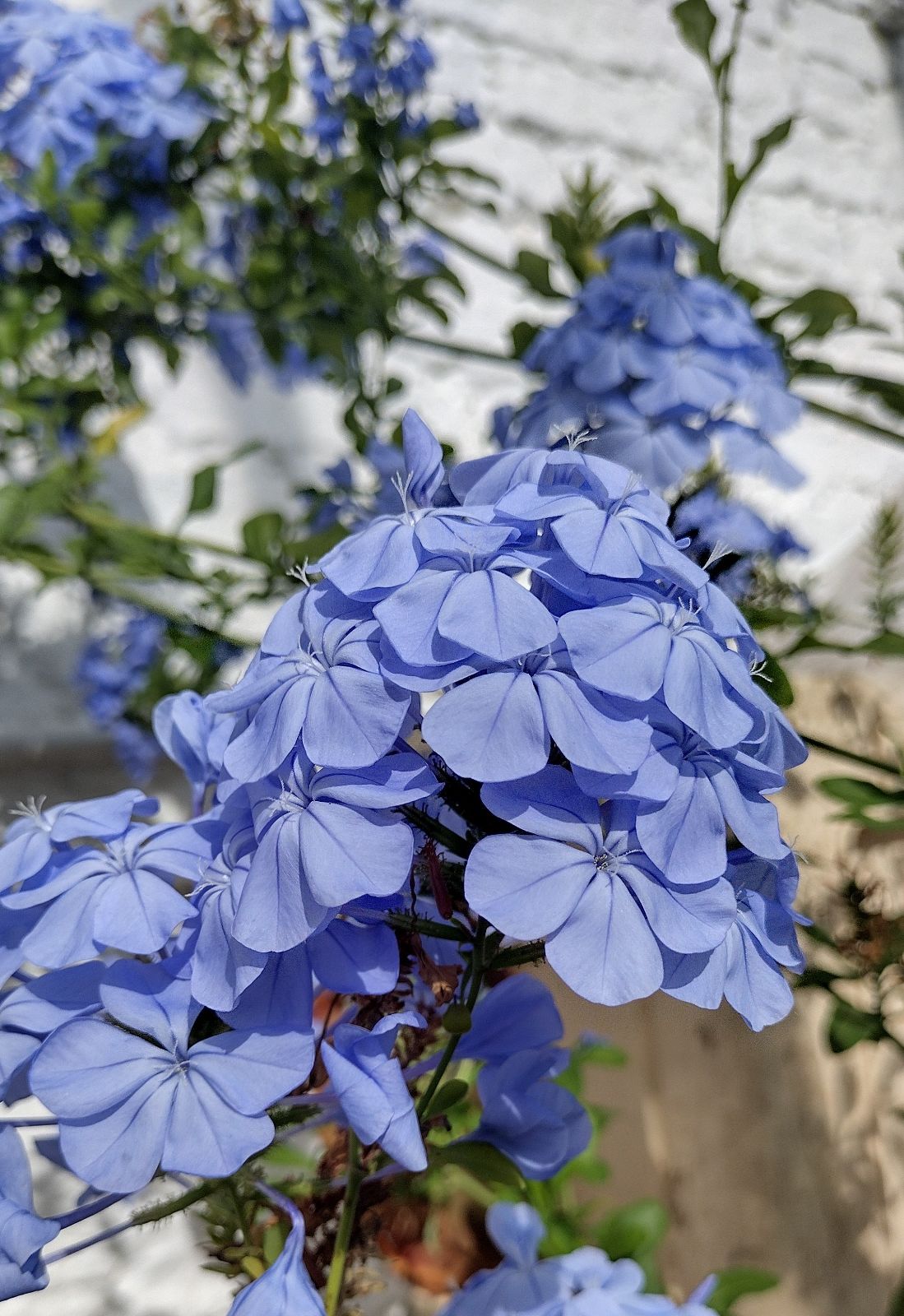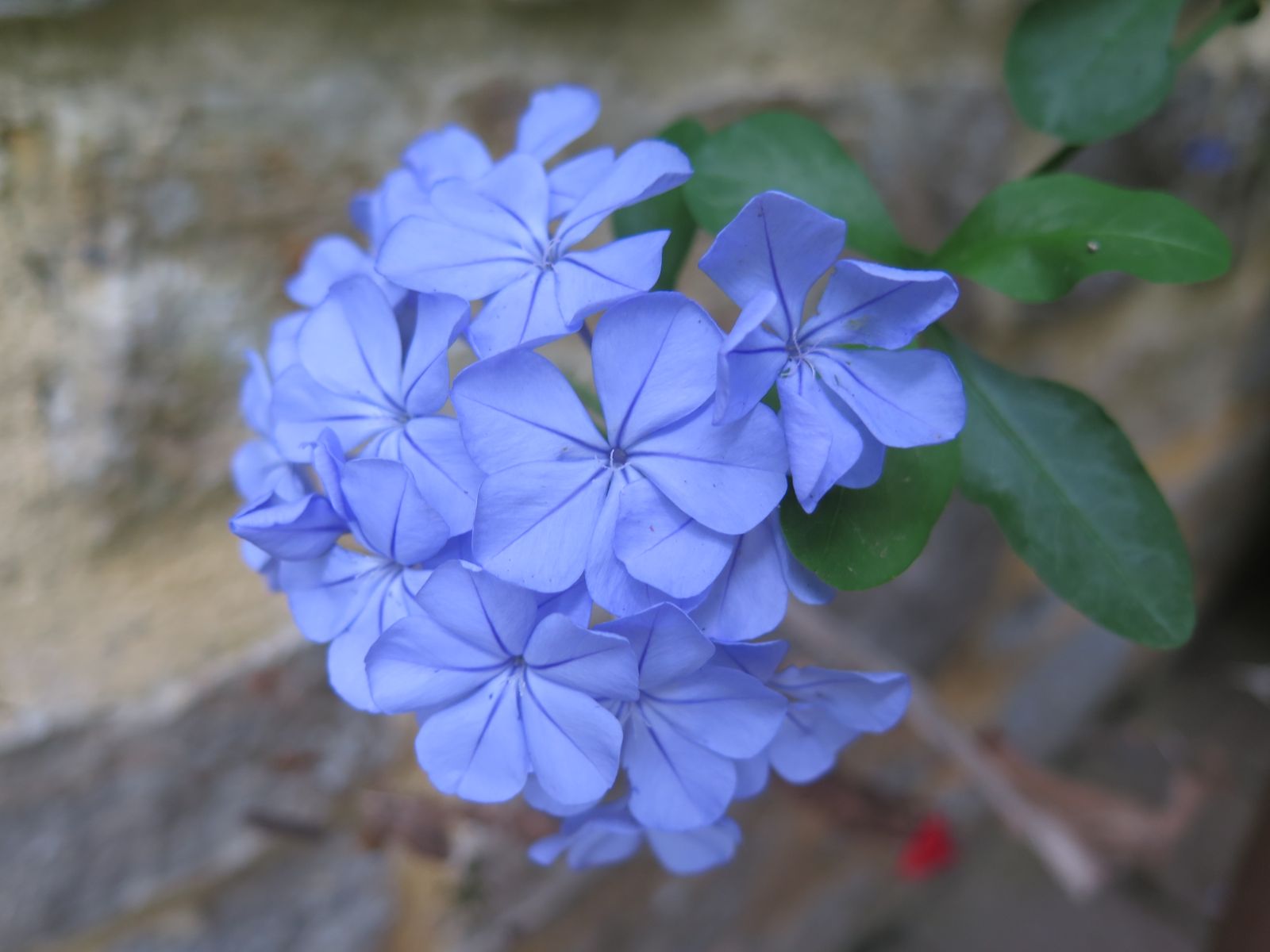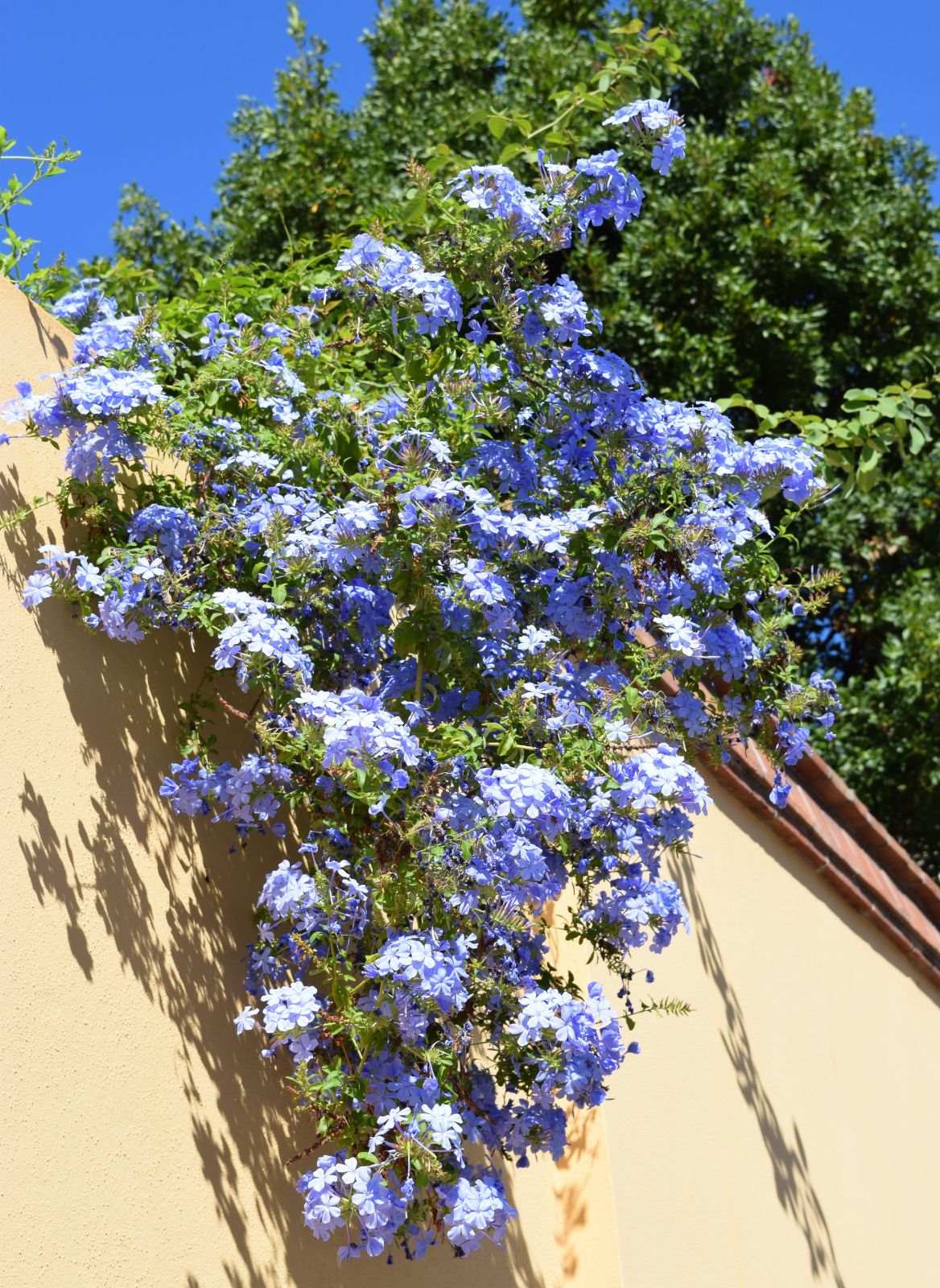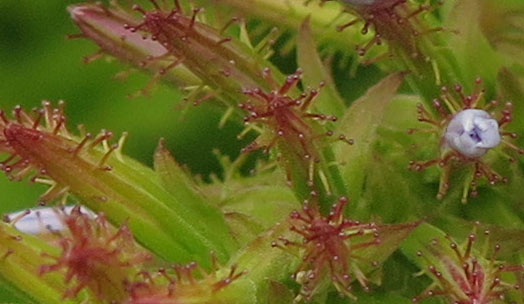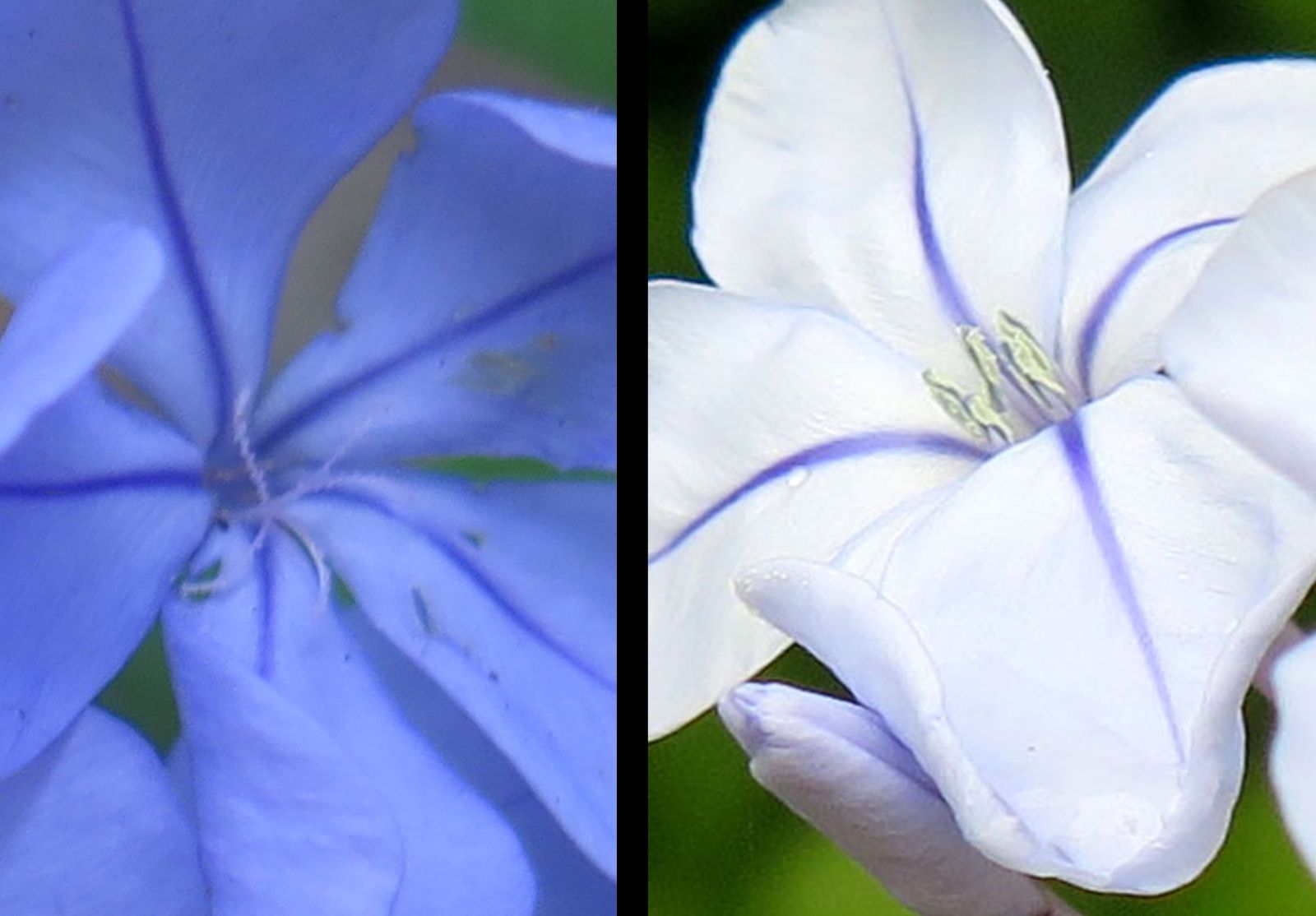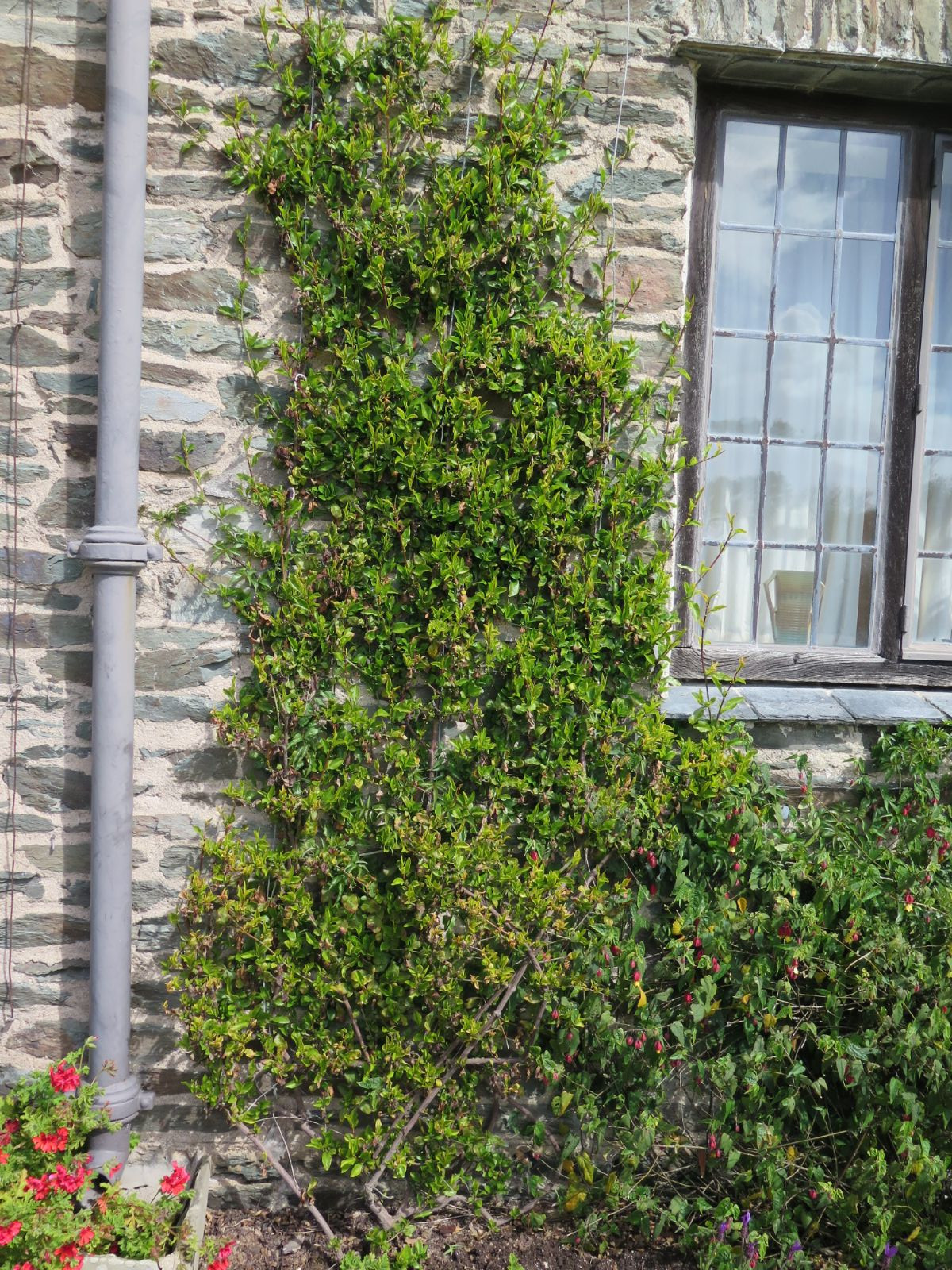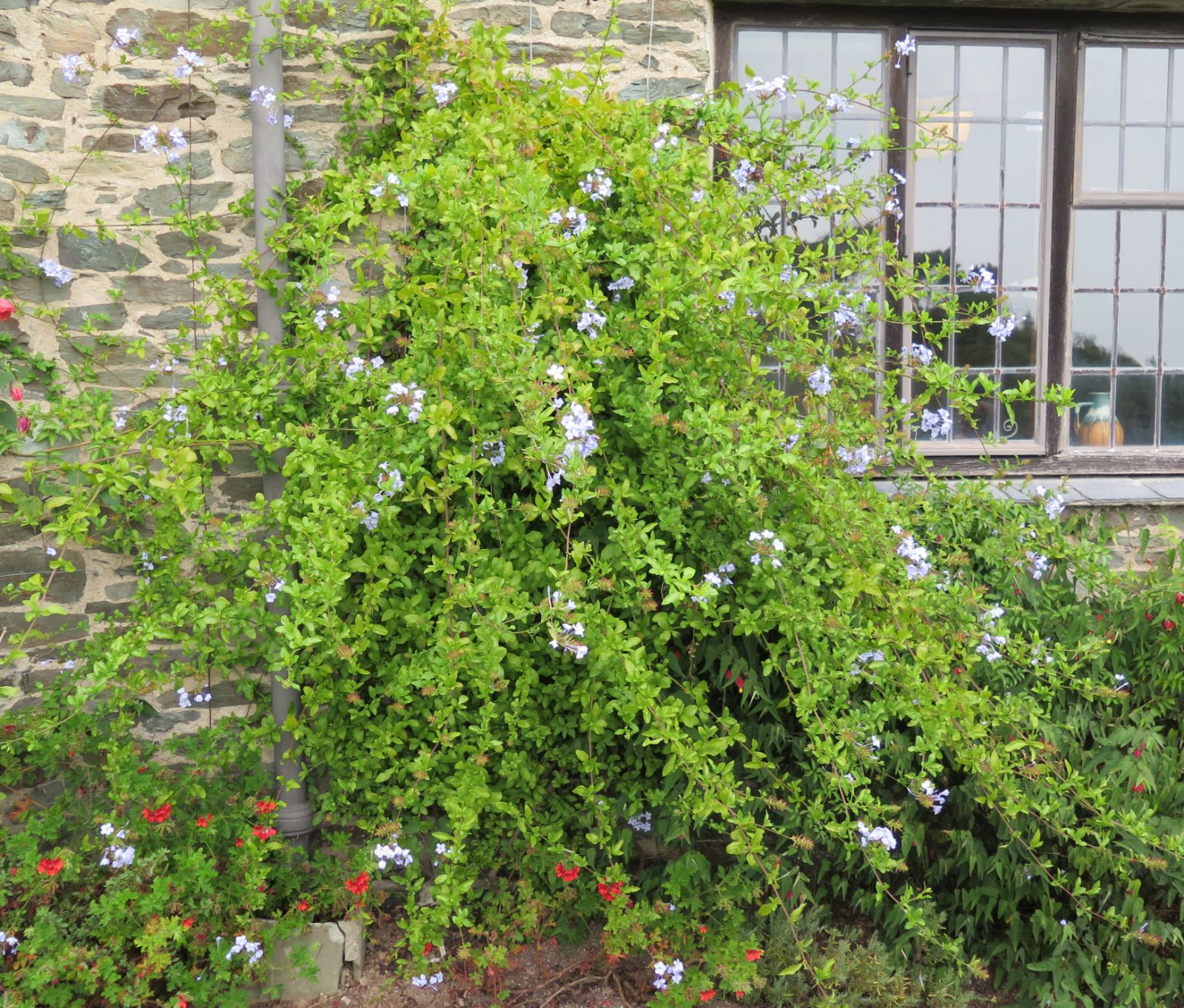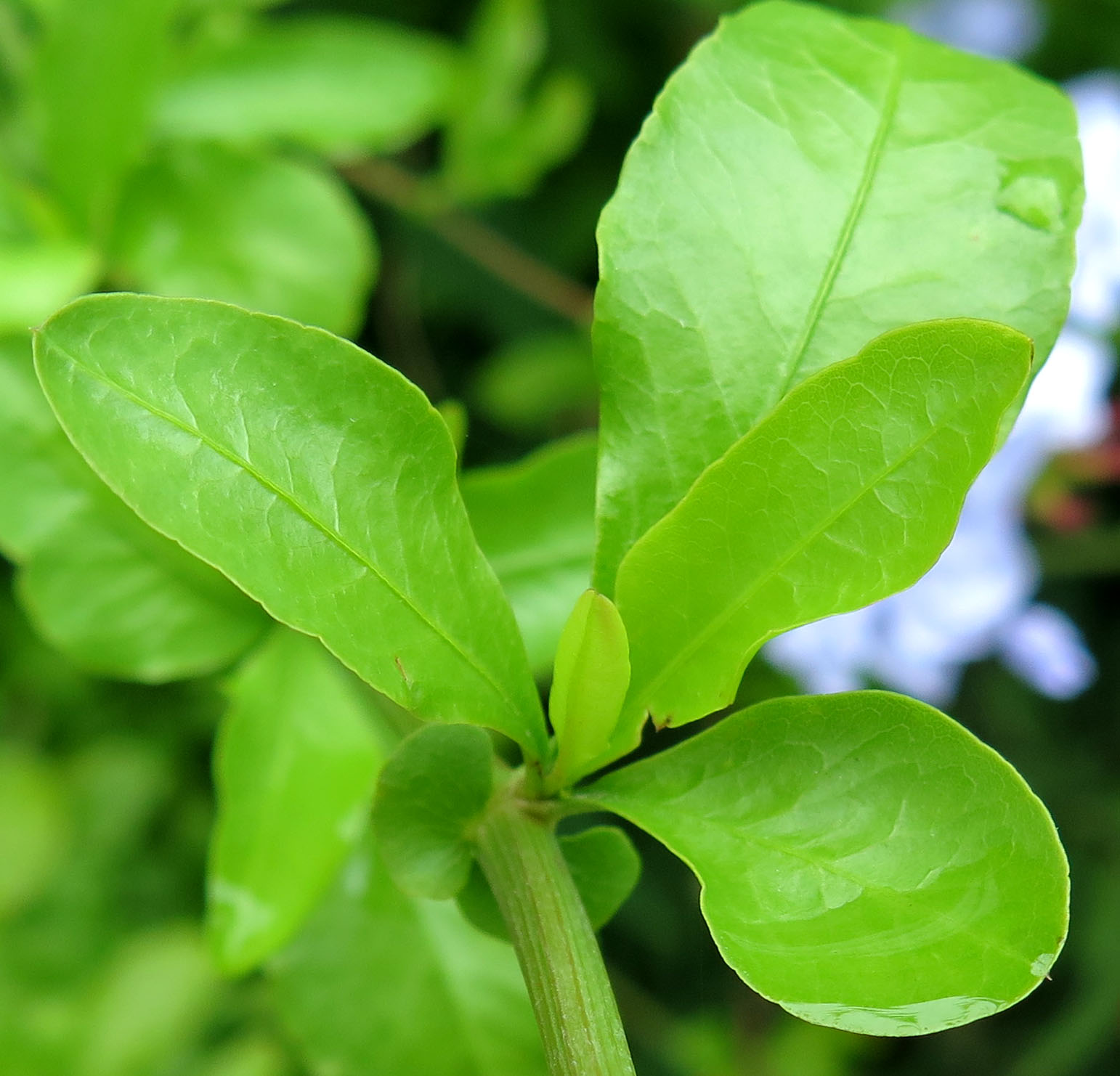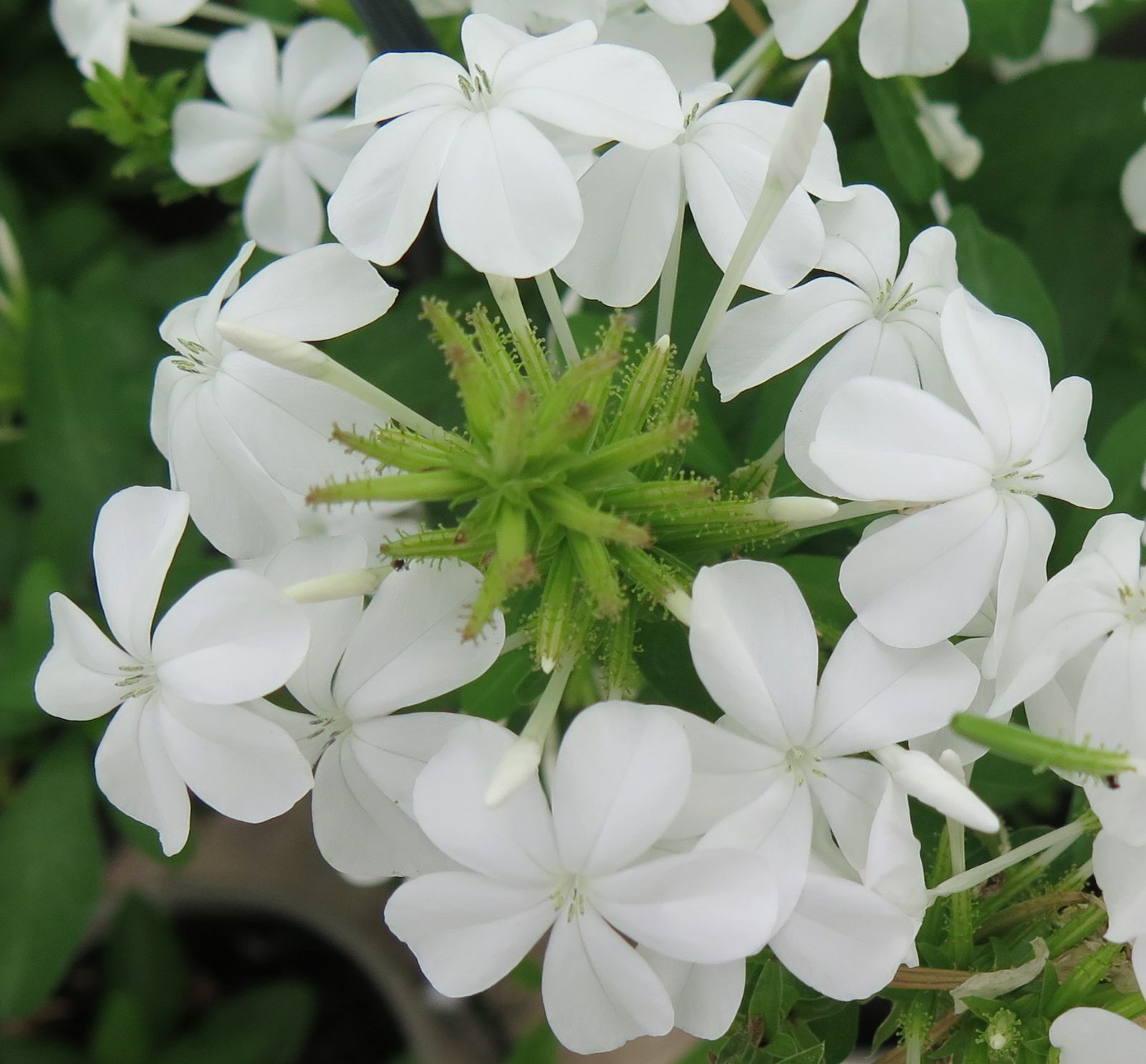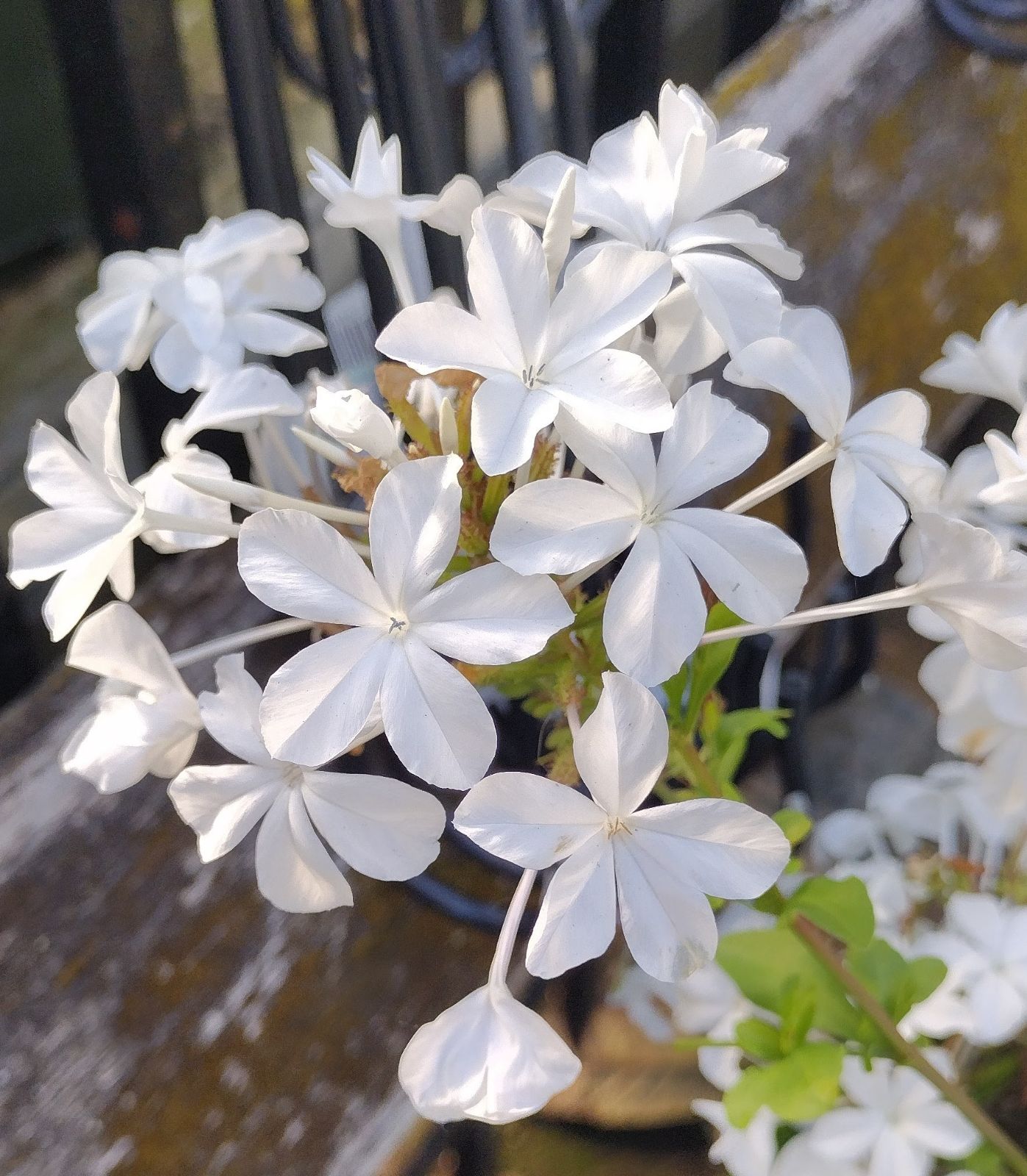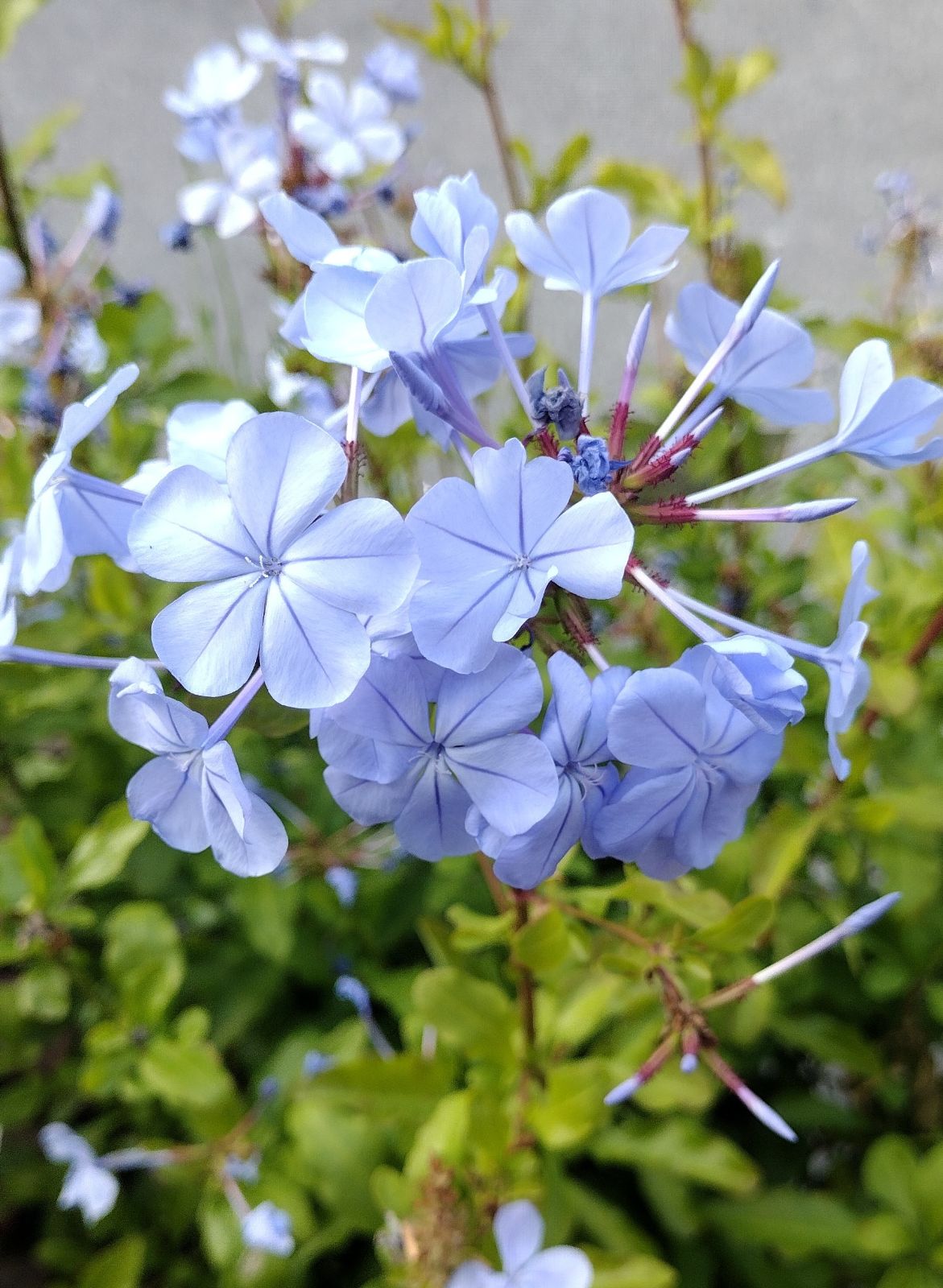Plumbago auriculata
Sponsor
Kindly sponsored by
a member of the International Dendrology Society
Credits
Julian Sutton (2021)
Recommended citation
Sutton, J. (2021), 'Plumbago auriculata' from the website Trees and Shrubs Online (treesandshrubsonline.
Evergreen shrub to about 3 m, suckering from the base and sprouting freely when cut back. Stems erect, arching, semi-scandent or trailing; ribbed, glabrous or with fine hairs on the youngest shoots. Leaves spathulate, obovate or elliptic, to 5 × 1–2.5 cm, glabrous or with scurfy scales beneath; apex obtuse, mucronate; base tapering, sessile or with short petioles, often with rounded auricles. Racemes capitate; peduncles with dense, short, white hairs; bracts ovate to lanceolate, to 1 cm. Calyx 10–13 mm long, ribbed, with short white hairs, and sticky-glandular on the upper half. Corolla pale blue, to about 2.5 cm across, tube 3–4 cm long, lobes shallowly notched, often with darker midvein. Flowering early summer to late autumn, November–May in South Africa. (Vickery 1983; Cullen et al. 2011; Huxley, Griffiths & Levy 1992; Aubrey 2001; Wilmot-Dear 1976; Peng & Kamelin 1996).
Distribution Mozambique South Africa Eastern, from Mpumalanga to southern Cape
Habitat Scrub and thickets (valley bushveld), common in saline habitats; 0–1600 m asl.
USDA Hardiness Zone 8-11
RHS Hardiness Rating H2
Awards AGM
Conservation status Not evaluated (NE)
There is nothing quite like Plumbago auriculata. With its pale sky-blue flowers over a long summer season, its strongly growing, arching stems which can be tied in to a wall or allowed to make an informal mound, its ability to regrow quickly from pruning, its ease of propagation and relative freedom from pests and diseases, this is a plant seemingly made for gardens. However, despite established plants regrowing readily from the base when frosted, it is killed by penetrating cold, and so is too tender for most of our area, where it has the status of a cool-greenhouse classic.
Its garden worthiness meant that P. auriculata was already being grown far from Southern Africa by the time it was described scientifically. Lamarck’s (1786) description was based on material from south east Asia, probably taken there from the Cape on Dutch East India Company trade routes (Aubrey 2001). His specific epithet refers to the auriculate leaf bases, a frequent but not universal feature. Thunberg’s later name P. capensis, based on South African material, was for many years more familiar to gardeners.
The flowers, with their long, slender tubes, spreading corolla lobes, and nectar production are adapted to pollination by long-tongued insects. In a wild KwaZulu-Natal population, the main pollinators were butterflies and various long-tongued flies (Ferrero et al. 2009) – specialist flower-visiting flies are important pollinators of long-tubed flowers in southern Africa. Animals are probably also important in seed dispersal. The sticky, glandular-hairy calyx is thought to stick to fur, carrying the seed capsule away; South African children make use of this, sticking flowers to their ears like earrings (Aubrey 2001).
Heterostyly has been clearly demonstrated in wild P. auriculata (Ferrero et al. 2009). There are two floral morphs, each plant producing only one or the other. In the short-styled morph, the stigma is barely visible in the mouth of the tube, while the anthers are held well above the mouth. In long-styled flowers, the anthers are only just above the mouth of the tube, on shorter filaments, while the stigma is held well clear. Pollen will then tend to be deposited on the pollinator in a place corresponding to the other morph’s style position, promoting cross pollination. Coupled with this, a heteromorphic incompatibility system prevents pollen from one morph fertilizing the other, even if pollination is successful. To the gardener, this means one thing, for better or worse: one morph, no seed.
The pale blue flowered form is absolutely the norm in the wild (Phillips & Rix 1997; Aubrey 2001), but two rare colour variants have become common in gardens. Firstly there are whites (f. alba, see below). This is an all-or-nothing character, a single gene apparently underlying the difference between it and the wild type (Shen et al. 2020). Then there are rather deeper blues, usually with a still darker petal midvein. These seem to be rather similar to one another in colour, and are absolutely not the intense, dark blue of Ceratostigma spp., however much one might wish for this. Again, there seems not to be a spectrum of intermediates linking them to the wild type. There is no established name for this variant. Cultivar names have sometimes been attached, including ‘Chessington Blue’ (Phillips & Rix 1997) and ‘Crystal Waters’, while ‘Escapade Blue’ is an F1 seed cultivar; often they are labelled simply ‘dark blue’, while the French equivalent bleu foncé is sometimes seen styled as a cultivar name. ‘Monott’ (see below) has this colour along with other desirable traits.
There is more to a good cultivar than flower colour. Shen et al. (2020) showed that flower size and both size and number of inflorescences in P. auriculata were strongly influenced by genes, and so are amenable to selection. They also found that in the offspring of crosses, these characters could fall beyond the range of the parental plants. The global success of ‘Monott’ shows that there is an opening for cultivars selected across a range of traits. Jiang et al. (2020) demonstrated that induced polyploids continued growing at lower temperatures than the usual diploids; this is not the same as frost hardiness, but is an early indication that hardier cultivars might one day be bred.
Following its spread in the tropics, P. auriculata was certainly grown in Europe by the early 19th century, when material from Colville’s London nursery, grown from seed sent from the Cape to London plantswoman Lady Sofia de Clifford, was illustrated in Curtis’s Botanical Magazine and its rival The Botanical Register (Sims 1819; Edwards 1819). More recent reference books have tended to avoid venturing a date of introduction, although Chittenden (1951) gives 1818, presumably a conservative inference from these illustrations. Edwards (1819) mentions that it had been grown much earlier, including (probably) at Kew, but was ‘long ago lost in this country’. We might speculate that the earlier introduction was by either Carl Thunberg, collecting in South Africa 1772–1775 and who named the species P. capensis, or Francis Masson collecting for Kew (again 1772–1775), or indeed the pair, who met and collaborated, working in concert. John Grimshaw (pers. comm. 2023) notes that a 1789 painting ‘Flowers in a Vase’ by Paulus van Brussel working in Amsterdam (The National Gallery 2023) includes an unmistakeable spray of Plumbago auriculata. This is further evidence that the species was in Europe well before the end of the 18th century, and is compatible with a Thunberg / Masson introduction.
It was initially grown under glass, Sims (1819) calling it a ‘handsome little greenhouse shrub’. It soon came to be used in summer bedding too, particularly in Germany, specially prepared young plants being planted out as edgings (Robinson 1898); this is still sometimes seen. As a more permanent garden plant, it is often seen in the south of France, but in our area it is restricted to mild, sheltered, coastal positions in western France and south west England, as well as in urban heat islands. There have been some striking plants on walls and fences in Paignton, Devon at least since the 1970s, for example at Oldway Mansion, although they tend to come and go, probably being replaced after the coldest winters (C. Rogers pers. comm. 2021). There are big specimens in central London, for example at the Chelsea Physic Garden (Growing on the Edge 2018); in sunny courtyards it may be just too vigorous, he regrowth from annual pruning obscuring windows (C. Rogers pers. comm. 2021). However, sunlight may be what limits really good flowering (Arnold-Foster 2000; Growing on the Edge 2018), the sun being so much lower in the sky in London or Penzance than in Cape Town, San Francisco or Nice at equivalent times of year.
In our North American area, this species is well suited to much of California; in the Bay Area it is common and permanent in gardens and roadside plantings. At the southeastern edge of our area in Greensboro, NC, it is marginally hardy (New Garden 2021).
Semi-ripe cuttings, of non-flowering lateral shoots, taken with a heel, can easily be rooted with bottom heat and humidity (Huxley, Griffiths & Levy 1992). Where seed is set, it should be sown, covered, in spring; on a smaller scale, rooted suckers can be dug from well established plants (Aubrey 2001).
f. alba (Pasq.) T.H.Peng
Synonyms
Plumbago auriculata 'Alba'
Awards
AGM
All white flowered forms are placed here. More than one clone is certainly in cultivation: F1 seed cultivars are available (e.g. ‘Escapade White’, marketed since about 2005 – Nature & Garden 2021), and a trawl of internet images found both long- and short-styled morphs (pers. obs. 2021). Even so, it has a reputation for being less vigorous (Aubrey 2001), perhaps because a weaker clone has been much propagated vegetatively. ‘Wonderful for working gardeners who only see their gardens in the twilight – the white blooms appear to glow in the dusk’ (Aubrey 2001).
'Monott'
Synonyms / alternative names
Plumbago auriculata ROYAL CAPE®
One of the darker blue varieties (see above), this is a floriferous plant, with larger flowers which continue to be produced in large numbers later in the season when typical plants make fewer flowers and more leafy growth. More compact than most, stems of new shoots have fewer rather than shorter internodes. A clonal cultivar from California, it was selected from a seedling group in 1988 by Paul Scott, and marketed globally by Monrovia Nursery Co. (Justia Patents 2021; Monrovia 2021). Plant Patent 7822 granted 1992.

